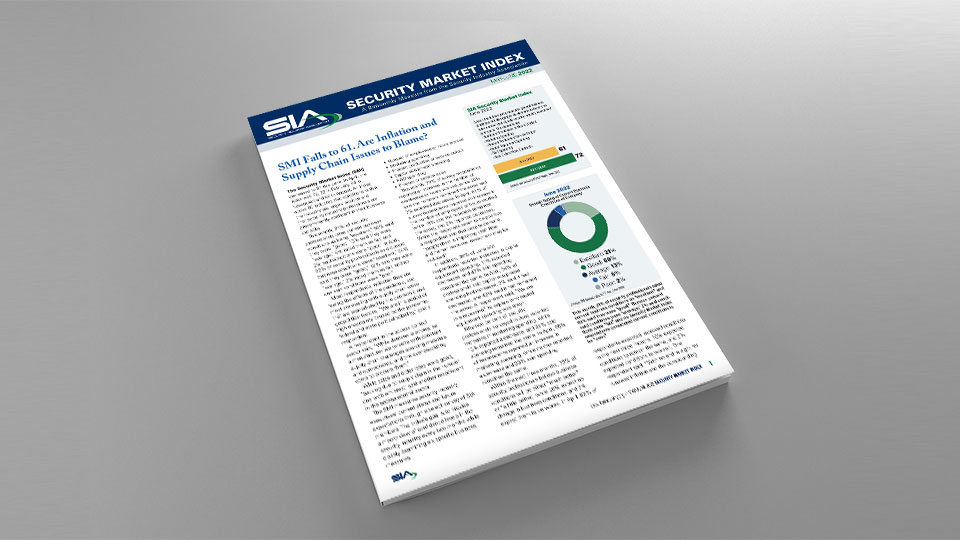Recession or Not? For Security Industry, the Real Question Is Still the Supply Chain

During this time of Schrodinger’s Recession – with the U.S. economy simultaneously in a recession and not in one – the resilience of the security industry during downturns is being tested.
The economy contracted at an annualized rate of 0.9% during the second quarter, following 1.6% shrinkage from January to March, according to the Bureau of Economic Analysis. Experiencing two consecutive quarters of negative growth has traditionally been regarded as a recession, but some analysts – not to mention President Biden and his administration – note that the National Bureau of Economic Research is the official scorekeeper for recessions, and that organization has not yet made a determination.
Treasury Secretary Janet Yellen insisted in late July that “This is not an economy that’s in recession. But we’re in a period of transition in which growth is slowing, and that’s necessary and appropriate, and we need to be growing at a steady and sustainable pace.”
Whether a recession or not, many businesses across the economy are facing difficulties; however, since security, both physical and digital, is typically considered to be a need, not a luxury, the industry has a reputation for being, if not recession-proof, at least recession-resistant (maybe even “period of transition”-resistant). Cutting back too much on security spending, especially in certain sectors, could have both compliance and market repercussions.

Protocol.com, an online news organization that covers technology issues, reported in June, for example, that William MacMillan, a senior vice president at Salesforce and former chief information security officer for the CIA, advised that, “It doesn’t work anymore to say, ‘We can cut back on security as long as we get the business done. Because you won’t get the business done if you don’t prioritize getting it done securely.”
While MacMillan was discussing cybersecurity, similar considerations can apply to physical security spending, especially when security operations have converged and physical and cyber controls are interdependent.
But few industries can survive a slowdown unaffected. While security is not a budget line item that can be zeroed out, projects can often be scaled back or postponed, and security leaders among SIA’s membership say they are feeling the impact of multiple economic headwinds. In addition to the recent contractions in gross domestic product (GDP), businesses are still challenged by the lingering effects of COVID-19, Russia’s invasion of Ukraine and the resulting economic ripples and other factors.
“We are in a period of high uncertainty caused by the pandemic [and] federal and state political volatility,” one SIA member said.
That uncertainty is being exacerbated by ongoing logistical problems. In some cases, the consumer is willing, but the supply chain is weak.
“While demand is strong, as a manufacturer, we wrestle with constant supply chain challenges sourcing materials and components, and the ever-escalating costs to procure them,” a member who works in physical access control said.
Other members echoed this comment, with one saying, “Backlog due to supply chain is the number one problem area,” and another noting that, “Supply chain is impacting cash flow and human resource investment may be reduced.”
In SIA’s 2022 Membership Satisfaction and Awareness Survey, the results of which were announced in late June, supply chain was cited as the most critical business issue. A related challenge, inflation, came in at No. 4.
Cost increases are at a four-decade high, with the June Consumer Price Index 9.1% higher than it was a year earlier, the Bureau of Labor Statistics reported. Energy prices, in particular, are spiraling, having increased 41.6% from June 2021 to June 2022, while gasoline prices, specifically, shot up nearly 60% during that time.
“It’s killing profitability,” a security manufacturer said. “Gas prices, alone, hurt us all.”
The Federal Reserve has responded by increasing interest rates by a total of two percentage points in the past three months. It is unclear, though, how quickly that, and possible future hikes, will rein in inflation – or whether it might produce an overcorrection that pushes the nation, definitively, into a recession.
At least one SIA member was less than optimistic, lamenting that there was “no end in sight for runaway inflation and the compounding supply chain challenges we continue to face.”
At the same time, however, some indicators are trending positive. The May-June edition of the SIA Security Market Index, a bimonthly survey of industry confidence, showed a generally positive outlook among SIA members, with 80% rating current business conditions at their company as “good” or “excellent” and only 7% saying “fair” or “poor.” And while the percentage of respondents expecting business conditions to improve in the following three months decreased by 10 points from the March-April survey, it was still a strong 73%.
In addition, whereas a recession typically means that a large number of people are out of work, the current unemployment rate, as reported by the Bureau of Labor Statistics, is 3.6%, only a tenth of a percentage point above its February 2020 level, and the economy added 372,000 jobs in June, bringing the year-to-date total to more than 2.7 million.
A Wall Street Journal article from early July gave some indication of the conflicting economic signs in its headline, “If the U.S. Is in a Recession, It’s a Very Strange One.” The combination of shrinking GDP and a strong labor market, the article stated, is “the latest strange twist in the odd trajectory of the pandemic economy, and a riddle for those contemplating a recession. If the U.S. is in or near one, it doesn’t yet look like any other on record.”
